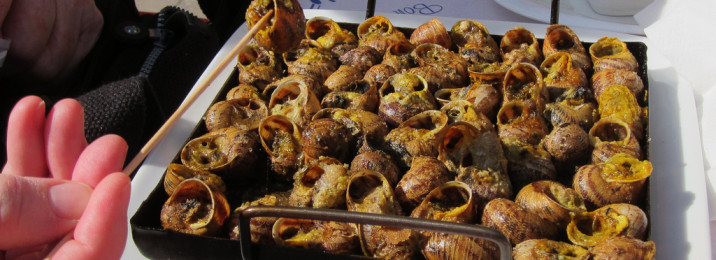What’s New in Tapas – Catalonia
Bordering France and Andorra to the north, Catalonia, like Basque Country, sits between two worlds: between Spain on the one hand and Europe on the other; between a fascinating past and an uncertain future; between the Spanish language and the Occitan dare I say dialects of Catalan and Aranese; and, soon, between a yes vote and a no vote on total independence at next year’s public referendum.
Being a land of contrasts, diversity, and interesting juxtapositions, this proud autonomous community to the north is bound to have some interesting tapas, right?
Well, the traditional Spanish ingredients are all here – tomatoes, peppers and aubergines are common, as are mushrooms, artichokes, beans, nuts, pork and fish – but it’s what the Catalonians do with these ingredients that sets them apart.
It’s common, for instance, to serve seafood up next to meat on the same plate (mar i muntanya in Catalan, or “sea and mountains” – the equivalent of our “surf and turf”), in dishes such as calamars farcits (squid stuffed with pork), and chicken with crayfish or lobster. It’s also common to find sweet and savoury ingredients blended seamlessly together, with popular examples including cheese and fruit jelly, prunes wrapped in bacon, chicken cooked in sherry, and hake or monkfish in a rich Romesco sauce (made with ground almonds and sweet red pepper).
Another classic tapa, the pa amb tomaquet, is unusual in that it’s essentially just a slice of bread, rubbed with fresh tomato and locally-produced Arbequina olive oil. Botifarra is also peculiar, since unlike other Spanish sausages it isn’t cured.
Aside from these few regional dishes, however, Catalonia wasn’t particularly well-known for its tapas (or tapes, to use the Catalan spelling). We like to think that Catalans are forever dreamers, full of creativity when it come to the gastronomic world. always experimenting and pushing the bar – they definitely have a diferente outlook on tapas, at least not in the way that southerners seem to.
You just have to look at a recent competition to see evidence of this. Held in Barcelona this past November, the Tapa de l’Any set out to find the “tapa of the year”, with judges looking not to the public, but to Michelin-starred chefs – pitting their recipes against each other in a live studio cook-off. The winning tapa – Buscant en Nemo (Finding Nemo) – consisted of tuna tartare with spherified tomato and soy sauce ‘caviar’ in a filo pastry case, delicately garnished in a contemporary Asian style. Other entries similarly drew on foreign influences, such as Thai, indicating a broad regional shift away from Spanish tradition.
Embracing world cuisines and experimental methods in this way is a trend that is sweeping Barcelona’s tapas scene. Tapas Royale on Carrer d’Escudellers, for instance, offers teriyaki chicken and salmon with black sesame, while Quimet i Quimet on Poeta Cabanyes serves salmon ‘sashimi’ with cream cheese, truffled honey, and soy.
Elsewhere is to be found the playful, postmodern creativity that has become so fashionable in foodie circles. Cervecería Catalana, harbinger of Barcelona’s modern tapas movement, is known for its mini hot-dogs, while Tapas 24 (run by elBulli’s own Carles Abellan) draws attention to its McFoie burger (pan-seared foie gras in an English muffin), roasted chicken nuggets, and “Bikini 24” (croque monsieur with truffle). Tickets, a modern tapas extravaganza on Avenida del Paral-lel, is run by Albert and Ferran Adrià and is more of an indoor theme park than a tapas bar, boasting among its attractions a futuristic room, an industrial room, and a Romeo and Juliet-inspired balcony. Its menu encapsulates the Asian twists (tempura pistachios and fish stew with shiitake mushrooms) and experimental techniques (mini airbags filled with Manchego cheese foam) that are taking Barcelona’s tapas world by storm.
There’s certainly no shortage of public interest in the trend; these new bars are extremely popular with the city’s style-conscious residents and many international tourists. But not only is this trend reinventing (or just plain inventing) the tapas themselves, it’s also reimagining what it means to eat them, and what the whole notion of going for tapas consists of. For most Spaniards, it’s an informal bar-hop with friends, yet at some of these new bars their very popularity means diners are left waiting around to be served or seated for extended periods of time. In the case of the Adrià brothers’ appropriately named Tickets, you aren’t even allowed to just turn up – you’re expected to make an online reservation at least sixty days in advance.
It’s not only in Barcelona that tapas is getting a Catalonian culture shock. In Girona to the north, Bubbles, an ultra-modern establishment clearly aimed at an international crowd, lists poached egg with foie gras, pea foam, and toasted Iberian ants among its chic delicacies, along with “translucent” duck cannelloni and grilled shrimp tartare with papaya chutney.
In Tarragona, there exists an organisation to determine the best local tapas of the year – much like the Tapas de l’Any competition in Barcelona – and this year’s winning entries have included foie gras mousse with strawberry salad and Coca-Cola, mushroom and rasberry risotto, and soft sponge cake with cream of salmon and spinach, all reflecting the Catalonian taste for contrasting flavors.
In fact, among the new wave of this region’s tapas bars, many offer a sweet selection alongside their savouries. Tickets in Barcelona place Sangria-infused watermelon at the top of their tasting menu, and across town in Tapas 24 you can opt for chocolate on bread with olive oil and salt. Likewise, Bubbles in Girona combines sauteed strawberries with pepper ice cream and yoghurt-coconut foam.
La Fabrica de las Tapas in Lleida, meanwhile, a town famous for its sweet turrón, offers a range of crema Catalana-based treats, using truffle and chocolate to craft their Muntanyas de Montserrat.
Whether the Catalonians ‘get’ the idea of tapas or not (indeed whether they’ll even be “Spanish” for much longer) is debatable, but either way they’ve had some very exciting ideas! and we look forward to what’s to come!


No comments
You can be the first one to leave a comment.